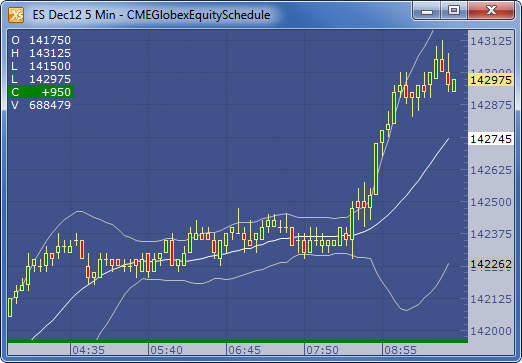Bollinger Band (BBANDS)
Bollinger Band (BBANDS)
Description
The Bollinger Band (BBANDS) study created by John Bollinger plots upper and lower envelope bands around the price of the instrument. The width of the bands is based on the standard deviation of the closing prices from a moving average of price.
Formula
Simplified:
Middle Band = n-period moving average
Upper Band = Middle Band + ( y * n-period standard deviation)
Lower Band = Middle Band - ( y * n-period standard deviation)
Where:
- n = number of periods
- y = factor to apply to the standard deviation value, (typical default for y = 2)
Detailed:
- Calculate the moving average. The formula is:

- Pn is the price you pay for the nth interval
- n is the number of periods you select
- Subtract the moving average from each of the individual data points used in the moving average calculation. This gives you a list of deviations from the average. Square each deviation and add them all together. Divide this sum by the number of periods you selected.

- Take the square root of d. This gives you the standard deviation.

- Compute the bands by using the following formulas:

Example

Subscribe to:
Post Comments
(
Atom
)
Follow us
Popular Posts
-
Decision Bar Indicator – Profitable strategy for swing Daytrading Decision Bar Indicator – Profitable strategy for ...
-
XARDFX forex trading system 2020 – best trading results about In conclusion, I would like to share a few powerful tips th...
-
Magic Fx Formula indicator-V2 About : It’s sophisticated enough to impress experienced traders, yet is so simple to use that even co...
-
Momentum MT4 Indicator What is Momentum MT4 Indicator? Thе Momentum Indiсаtоr (MOM) is a leading indiсаtоr mеаѕuring a ѕесuritу...
-
Trading Magister V1 System Powerful Features & Functions ✓ Three Trading Strategies: Asia, Europe & A...
-
ZigZag Based on Close Prices - indicator for MetaTrader 4 The code is based on indicator ZigZag which is in-built in MT4, devel...
-
VR Moving Average Forex Trading Strategy is a day trading strategy that is traded on the 5-minute chart. While some would consider the ...
-
Daily Bonus Come everyday to claim your Daily Bonus! Bonus multiplicator will increase every continuous day you claim till the end...
-
download
-
Stochastic Elasticity Indicator DOWNLOAD
Powered by Blogger.
Blog Archive
- October (44)
Labels Cloud
Categories
Pages
Video of the day
About
About Me
© TRADEBASE4 ..2018-2019 . Powered by Lifehacktricksall . Tradebase4 .




No comments :
Post a Comment